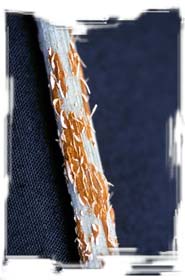CIMMYT E-News, vol 3 no. 12, December 2006
 Wheat lines that resisted virulent stem rust last season have now succumbed.
Wheat lines that resisted virulent stem rust last season have now succumbed.
Observations from wheat rust screening trials in Kenya indicate even more of the world’s wheat is at risk from a stem rust attack than originally thought. Scientists from CIMMYT and its partners, studying wheat planted at the Njoro Agriculture Research Centre, report that more than 85% of sample wheats, including cultivars from the major wheat producing regions of the world, have succumbed to the stem rust known as Ug99. Most importantly some wheat lines which showed resistance to Ug99 stem rust a year ago now appear to be susceptible to the disease.
In August, 2005 an expert panel raised the first alarm about the new, virulent form of stem rust that could devastate world wheat crops. These new observations could mean the threat to the global wheat harvest is now significantly greater.
The Njoro Research Centre is in an area of Kenya where the virulent form of stem rust fungus is endemic. For the past three years scientists have used the station to expose wheat to the disease to see which is susceptible and most importantly, which is not. In March of 2006 more than 11000 different types of wheat and relatives of wheat from all over the world were planted and exposed to the fungus.
Studies are still underway to clarify the situation but it appears that at least one of the major stem rust resistance genes that has protected many of the world’s wheats for decades is no longer effective against the rust fungus at Njoro. This new development enhances the significance of what is already recognized as a dangerous threat to future global wheat harvests.
Wheat grows on more than 200 million hectares in both the developed and the developing world and the new data indicate that very little of that area is planted to varieties which resist the stem rust found at Njoro. Though stem rust may not be able to thrive in all parts of the world, scientists estimate that well over half of the total wheat area could suffer rust epidemics if susceptible varieties planted there are exposed to the pathogen.
“I was shocked at what I saw this season,” says Rick Ward, coordinator of the CIMMYT-ICARDA led Global Rust Initiative. “Essentially we have to find a way to replace all of the world’s wheat.”

Stem rust is one of the most dreaded of all plant diseases. In the mid-1950s it wiped out up to 40% of the North American spring wheat crop. Thanks in large part to the wheat breeding work of Nobel Peace Prize laureate, Dr. Norman Borlaug and those who followed him, the disease has not been a significant threat for almost half a century. Breeders combined several sources of resistance to the fungus into new varieties of wheat. Unfortunately, over time, the rust pathogen evolved and mutated and in 1999 scientists found a strain in Uganda (Ug99) that could bypass much of that resistance. The spores of the Ug99 fungus can travel great distances on the wind. The pathogen has already spread from Uganda into Kenya and Ethiopia. An outbreak of yellow rust originated in the same region of eastern Africa and eventually spread across the Arabian Peninsula and into the major wheat-growing areas of India and Pakistan. Studies of wind patterns in the region have led scientists to conclude that the new pathogen will eventually threaten wheat crops on a global scale.
CIMMYT and the International Center for Agricultural Research in the Dry Areas (ICARDA), together with partners such as the Kenya Agricultural Research Institute (KARI) are leading a global effort to characterize the rust pathogen; to track its spread and to find new sources of resistance to the disease and breed them into new wheats. This is especially important to farmers in the developing world who have little access to fungicides that could help reduce the damage.
“The good news is that some samples at Njoro did resist the fungus,” says CIMMYT wheat scientist, Ravi Singh. “That has given us a good place to start.” In fact Njoro is also the site where potential resistant breeding lines are now undergoing test.
For more information, Rick Ward (r.w.ward@cgiar.org)
 Climate adaptation and mitigation
Climate adaptation and mitigation 
